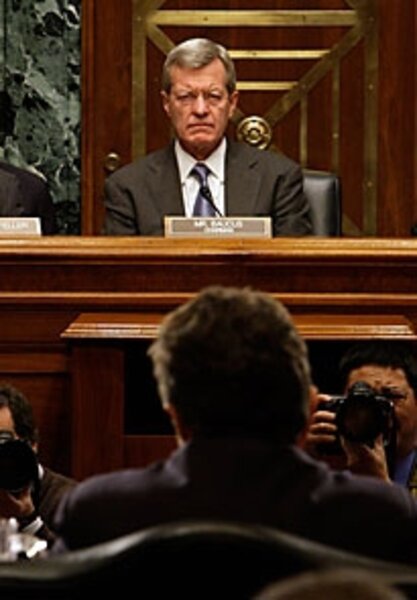Bailout tab: $3 trillion so far
Loading...
| Washington
Cash commitments made by the US government to its main bailout efforts – the Treasury's Troubled Asset Relief Program (TARP), various Federal Reserve Board programs, and some others – have now reached at least $2.98 trillion, Neil Barofsky, Special Inspector General for TARP, told the Senate Finance Committee at a hearing Tuesday.
That estimate does not include the cost of any further aid for GM and Chrysler or the warranty support program announced Monday by President Obama. It does not account for the $750 billion cushion against possible future bailouts that Mr. Obama included in his fiscal year 2010 budget request.
Even so, that astounding total is about as big as the entire federal budget was before the current financial storm began.
"It's like having a second US budget dedicated solely to saving the US financial system, and that truly is surreal," said Finance Committee chairman Sen. Max Baucus (D) of Montana.
The $2.98 trillion figure represents tax dollars that are committed to bailout operations, not money that has been appropriated and spent.
The TARP – the original financial rescue fund, passed last year after great effort by the Bush administration – is almost out of money. The Treasury has announced plans for about $667 billion of its $750 billion in TARP funds. About $300 billion of the $667 billion has already been sent to participating banks.
The Obama administration has been careful to depict the TARP as broad-based, helping banks in cities and towns all across the nation. That is true, in the sense that 364 institutions throughout the US have received TARP money, said Mr. Barofsky. But, "the majority of the funding went to a small number of recipients, with 26 firms receiving approximately 93 percent" of TARP cash, he said.
Tracking what banks do with TARP money once they get it remains a big issue in Congress. Rather than wait for the Treasury to produce data on the issue, Barofsky said he went ahead and asked all 364 recipients of TARP cash to report on how they'd used it.
They all responded. Some provided more detail than others, but overall “one thing is clear: Complaints that it is impractical, impolitic, or a waste of time to get banks to detail their use of TARP funds are unfounded,” said Barofsky.
Still, both Senators and oversight officials at Tuesday's hearing complained of being left in the dark by the Treasury. The Treasury official in charge of TARP, Neel Kashkari, declined to appear and answer questions at the session.
“There is no transparency. It means Congress and the American people have been cut out of this equation,” said Elizabeth Warren, chair of the Congressional Oversight Panel for TARP.





